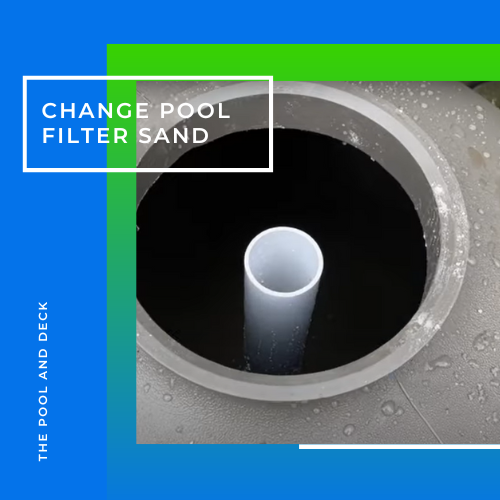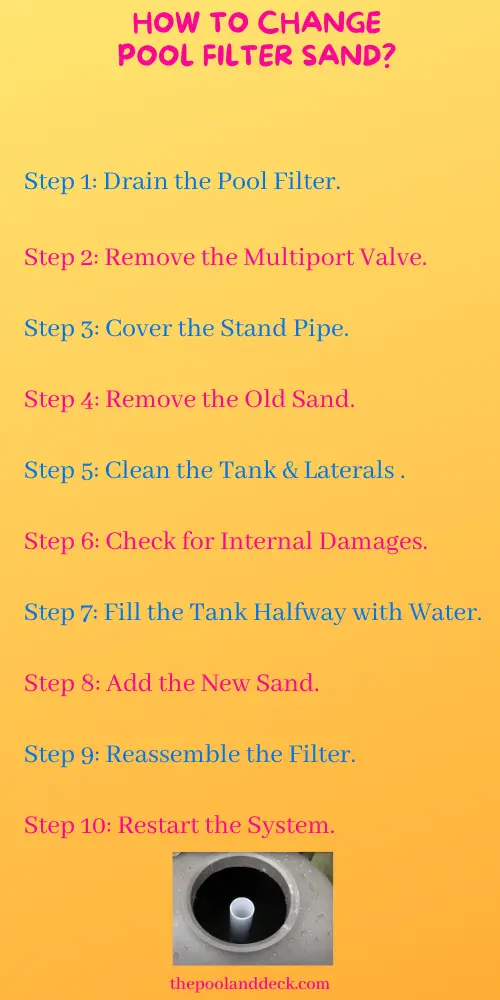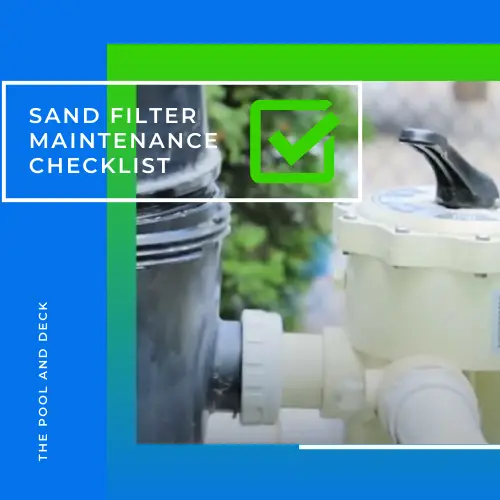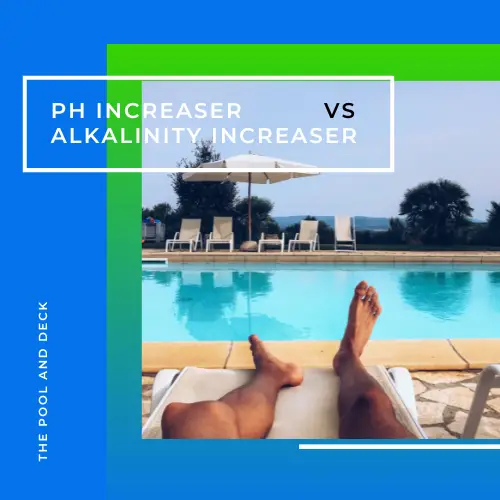How To Change Pool Filter Sand? An Easy 10 Step Guide!
Table of Contents
Should I Clean or Change Pool Filter Sand?
Like it or not, a time will come when backwashing will not suffice. It will be time to change pool filter sand. The jagged edges of the sand grains get smoothened over years of service. The sand grains are no longer able to trap debris effectively.
Did you get a new pool a few years ago? Do you find that the pool sand filter is no longer as efficient as it used to be? This is only natural!
A pool sand filter traps the solid contaminants in the pool water by pushing it through the sand inside. The angular sand grains form fine, irregular channels through which water can flow but larger solid particles can not.
As the particles get trapped they further constrict the passage through the sand. In fact, a slightly dirty pool sand filter works even better than a totally clean one.

Then a stage comes when the passage becomes too restrictive and the filter starts clogging up. This is why you need to backwash your pool sand filter when the pressure reading hits about 10 psi higher than the normal psi reading.
Backwashing essentially reverses the water flow such that the trapped contaminants are flushed out of the filter and drained away.
Over a period of time the continuous filtering and backwashing erodes the angular projections in the sand. The sand grains lose their roughness and become smooth and rounded. Just like smooth pebbles which have been lying in a stream for centuries!
Once the sand grains become too smooth they are unable to trap the solid contaminants as effectively. The particles can now wiggle and glide over the smooth sand grains. A stage comes when sand filter sand replacement is the only practical solution.
Why Change Pool Filter Sand?
The main reason to change pool filter sand is to ensure that your pool filtration system can once again start functioning at the optimum efficiency levels. In case the sand filter sand replacement is not done at the right time it will result in
- cloudy, dull pool water
- reduced water circulation
- higher energy bills
- excessive strain on the system
- costly repairs & high maintenance costs
When to Change Pool Filter Sand?
As a general rule of thumb, it’s best to change pool filter sand every three to five years. This rule of thumb applies to silica sand.
Other media such as Zeolite or Recycled Glass have longer life and may last for five to ten years before sand filter sand replacement becomes necessary.
Over time, the sand in the filter gets compacted, the sand grains get smoothened and not all of the grime that the filter collects can be cleaned by backwashing or using a filter cleaner. The pool sand filter loses its effectiveness in filtering out impurities from the water.
By changing the sand at regular intervals, you can ensure that your pool equipment functions properly and the pool water remains crystal clear, clean and safe for swimming.
Some telltale signs that sand filter sand replacement is due are:
- Cloudy & dull pool water in spite of perfect pool chemistry parameters
- Pump pressure continues to be high even after backwashing
How Much Sand to Add to the Pool Filter?
The amount of sand required for your pool filter is a function of the filter size. The volume of the pool filter tank can be calculated using the formula:
Volume =π X radius X radius X height
As best practice the sand must fill up ⅔ rds of the filter tank volume. So multiply the filter tank volume by 0.67 to get the sand volume. Based on the sand density you can calculate the weight of the sand required.
You can use the Table below as a quick guide.
| Tank Diameter (Inches) | Sand Required (lbs) |
| 16 | 100 |
| 18 | 150 |
| 19 | 175 |
| 20 | 200 |
| 22 | 250 |
| 24 | 300 |
| 27 | 350 |
| 30 | 500 |
| 36 | 700 |
Better still refer to the user manual of your pool filter!
How to Change Pool Filter Sand?
1. Drain the Pool Filter
You need to turn off the pool pump and filter system. Make sure that the pump timer is inactivated. Relieve the pressure in the system by opening the air relief valve on the filter.
Drain the water by removing the drain plug from the bottom of the filter tank. Keep in mind that draining the water will take several hours.
2. Remove the Multiport Valve
The Multiport Valve is located on top of the pool filter assembly and has hoses or pipes leading from and to the pool. Disconnect the pipes and use a screwdriver to pry the multiport valve from the pool filter.
It is very important to be both gentle and firm so as not to damage the valve or the laterals.
3. Cover the Standpipe
You will find a vertical pipe running down the center of the filter tank, just under where the multiport valve was. This is the standpipe. You must cover this with a polythene bag or duct tape.
You do not want sand getting inside the standpipe, as the sand will end up in your pool, once you restart the pump.
4. Remove the Old Sand
Use a scoop or small plastic cup to remove the old sand from the filter. The job will be a lot easier and quicker if you have or can lay your hands on a shopvac.
This part is tough and backbreaking as you must remove all of the old sand. Any remaining old sand will mix with the new sand and adversely affect its performance.
5. Clean the Tank and Laterals
Once the old sand has been removed, clean the filter using a garden hose or pressure washer (at very low pressure setting) to rinse out any remaining sand and debris.
This will help to ensure that the new sand can filter the pool water effectively.
6. Check for Internal Damages
This is also a good time to visually check if the standpipe and laterals are in sound condition. In case they are cracked or damaged you will need to replace them.
7. Fill the Tank Halfway with Water
It is a good practice to fill the now empty and clean filter tank halfway with water using a garden hose. The water will cushion any impact on the laterals when you pour new sand in the tank.
8. Add the New Sand
Pour the new pool sand filter sand into the filter slowly and gently. Make sure to add the correct amount of sand, as specified in the pool sand filter manual.
9. Reassemble the Filter
Once the new sand has been added, reassemble the filter by placing the multiport valve on top of the filter and connecting the inlet and outlet hoses.
Make sure that all connections are tight and there are no leaks in the system.
10. Restart the System
Restart the pool pump and filter system. Double check for any leaks or other faults.
It is best to run the filter on the backwash setting for a couple of minutes. This will clear out any dust and debris that came with the new sand.
Follow this up by running the filter on rinse mode for a minute or so to remove any excess sand and ensure that it’s filtering the water properly.

Thank you very much for reading the post. I do hope you found it informative and helpful.






